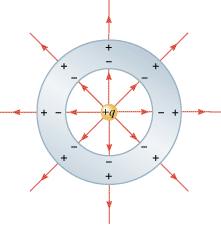|
A charge +q is suspended at the center of a hollow, electrically neutral, spherical conductor, as Figure 18.31 illustrates. Show that this charge induces (a) a charge of –q on the interior surface and (b) a charge of +q on the exterior surface of the conductor.
 | | Figure 18.31
A positive charge +
q is suspended at the center of a hollow spherical conductor that is electrically neutral. Induced charges appear on the inner and outer surfaces of the conductor. The electric field within the conductor itself is zero. |
|
Reasoning and Solution
| (a) |
Electric field lines emanate from the positive charge +q. Since the electric field inside the metal conductor must be zero at equilibrium under electrostatic conditions, each field line ends when it reaches the conductor, as the picture shows. Since field lines terminate only on negative charges, there must be an induced negative charge on the interior surface of the conductor. Furthermore, the lines begin and end on equal amounts of charge, so the magnitude of the total induced charge is the same as the magnitude of the charge at the center. Thus, the total induced charge on the interior surface is –q.
| | (b) |
Before the charge +q is introduced, the conductor is electrically neutral. Therefore, it carries no net charge. We have also seen that there can be no excess charge within the metal. Thus, since an induced charge of –q appears on the interior surface, a charge of +q must be induced on the outer surface. The positive charge on the outer surface generates field lines that radiate outward (see the drawing) as if they originated from the central charge and the conductor were absent. The conductor does not shield the outside from the field produced by the charge on the inside.
|
Related Homework:
Problem 57
|
